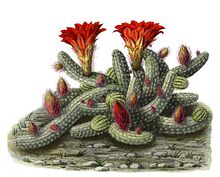|
Chamaecereus silvestrii
Chamaecereus silvestrii is a species of cactus from northwestern Argentina and Bolivia. Synonyms include Echinopsis chamaecereus and Lobivia silvestrii.[1] It has been called the peanut cactus.[2] This plant should not be confused with Echinopsis silvestrii, a synonym of Echinopsis albispinosa, a species with a very different appearance. Chamaecereus silvestrii has long stems about 1 cm (0.4 in) across. Orange flowers up to 4 cm (1.6 in) wide appear in late spring. In cultivation, Ch. silvestrii is hardy to temperatures as low as −7 °C (19 °F) if kept dry.[2] Ch. silvestrii was first collected and described in 1896 as Cereus silvestrii by Italian-Argentinian botanist Carlo Luigi Spegazzini in the mountains between the provinces of Tucuman and Salta, Argentina.[3] However, subsequent expeditions to the area failed to find the species Spegazzini had collected and it is unknown whether the species has gone extinct since the initial collection.[4] This plant is a recipient of the Royal Horticultural Society's Award of Garden Merit.[5]
References
|
||||||||||||||||||||||||||||||||


